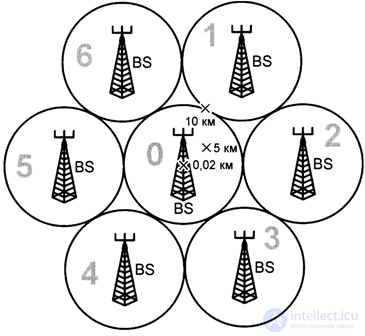Lecture
Formulation of the problem. Consider the cellular network of GSM stations (Fig. 7.28) and determine the level of electromagnetic radiation (power flux density) at arbitrarily selected points A, B, C of cell 0.

Fig. 7.28. Model of the cellular network.
Suppose that the main contribution to the creation of the electromagnetic field at points A, B, C of cell 0 is made by the antennas of the active base stations: BTSo at point 0 and the six BTSs surrounding the central cell, as well as operating mobile stations in the considered cells (at 1000 MS for one cell).
The solution of the problem.
The power flux density at selected points of the central cell will be found with the following initial data:
a) Suppose each GSM cell has a radius of 10 km, and in the center of each cell is a BTS base station, the maximum power of which is PBTS = 50 W and the antenna gain GBs = 1 dB.
b) Let the mobile station of the GSM network have the maximum transmitter power PMS = 2 W, and the antenna gain GMs = 1 dB.
c) Let the three points A, B, C of cell 0 are, respectively, at a distance of 0.02 km, 5 km and 10 km from the base station of the 0th cell.
In each of them, the power flux density P (W / cm2) is determined under the condition that all mobile stations are active in all nearby cells.
d) The determination of the value of P can be realized by dividing the task into several parts:
- the first is determined by the value of PM8, due to the radiation of the antennas of the transmitters of existing mobile stations

where PMsj is the radiation power of the transmitter antenna of the jth MS, GMSj is the antenna gain of the jth MS, d} is the distance from the jth MS to the selected point A, B, C of cell 0;
- the second is determined by the value of the power flux density nBs, due to the radiation of the antennas of seven base stations

where PBSi is the radiation power of the transmitter antenna of the i-th BTS, GBsi is the antenna gain of the i-th BTS, g, is the distance from the i-th BTS to the selected point A, B, C of cell 0;
- the third; since the power flux densities from each radiator are searched for as vectors averaged over a period, they should be geometrically added at a selected point and the module of the Umov-Poynting vector should be found.
As a result, we get the following final expression:

The results of the calculations show:
- at point A with RA = 0.02 km, the value of P = 0.562 μW / cm2;
- at point B with Rb = 5 km, the value of P = 0.164 μW / cm2;
- at point C at Rc = 10 km, the value of P = 0.164 μW / cm2.
Thus, the values of the flux density at points A, B, C do not exceed the level of background safe electromagnetic radiation of 1 μW / cm2.
The results show that in the GSM system, with a maximum radio coverage of the service area by base and mobile stations, the electromagnetic radiation intensity does not exceed the background level equal to Pf = 1 μW / cm2. Thus, the installation of base stations of the GSM standard does not lead to an increase in the level of electromagnetic background and cannot cause the negative effects of electromagnetic radiation on the health of the population living near the base transceiver stations.
Comments
To leave a comment
GSM Basics
Terms: GSM Basics